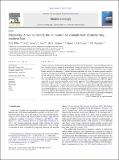Palynology: A tool to identify abrupt events? An example from Chabahar Bay, southern Iran
Abstract
Tsunami, storm and flood events are destructive agents that have the potential to cause much damage and cost lives. The coastal regions around the north-western Arabian Sea are prone to these natural disasters with recent events including the storm and flood of AD 1842, the Makran tsunami of 1945, and Cyclone Gonu in 2007. Despite their severity, the paucity of reliable historical records does not allow us to answer pertinent questions concerning their frequency, intensity and impact. Palaeo-event analysis from the geological record allows us to extend, and test, the historical record. Here we have dated and examined a 92 cm long sediment core from the tectonically active, cyclone and storm prone Chabahar Bay area (southern Iran). Our appraisal directly tests conventional proxies for identifying abrupt events (e.g. grain-size, geochemical data), which we supplement with a novel palynological (pollen and dinocyst) approach. Both sedimentological and palynological approaches suggest a large event which was dated at < AD 1808 ± 41, whereas geochemical approaches remain inconclusive. The increase of continentally derived pollen (Pinaceae, Salix, Betula and Typha–Sparganium), increases in Brigantedinium sp. and S. ramosus as well as decreases in Lingulodinium machaerophorum suggest enhanced fluvial delivery in association with a flood. This investigation provides evidence of a major flash-flood affecting the Chabahar Bay region at < AD 1808 ± 41 which we infer is the geological expression of the storm and associated flash flood of AD 1842. Moreover, our study demonstrates the utility of palynology in identifying and understanding the causes of abrupt events to complement more widely applied techniques.
Citation
Miller , C S , Leroy , S A G , Izon , G J , Lahijani , H A K , Marret , F , Cundy , A B & Teasdale , P A 2013 , ' Palynology: A tool to identify abrupt events? An example from Chabahar Bay, southern Iran ' , Marine Geology , vol. 337 , pp. 195-201 . https://doi.org/10.1016/j.margeo.2013.03.004
Publication
Marine Geology
Status
Peer reviewed
Type
Journal item
Description
Funding: L.Miller,G.Miller and Brunel UniversityCollections
Items in the St Andrews Research Repository are protected by copyright, with all rights reserved, unless otherwise indicated.

